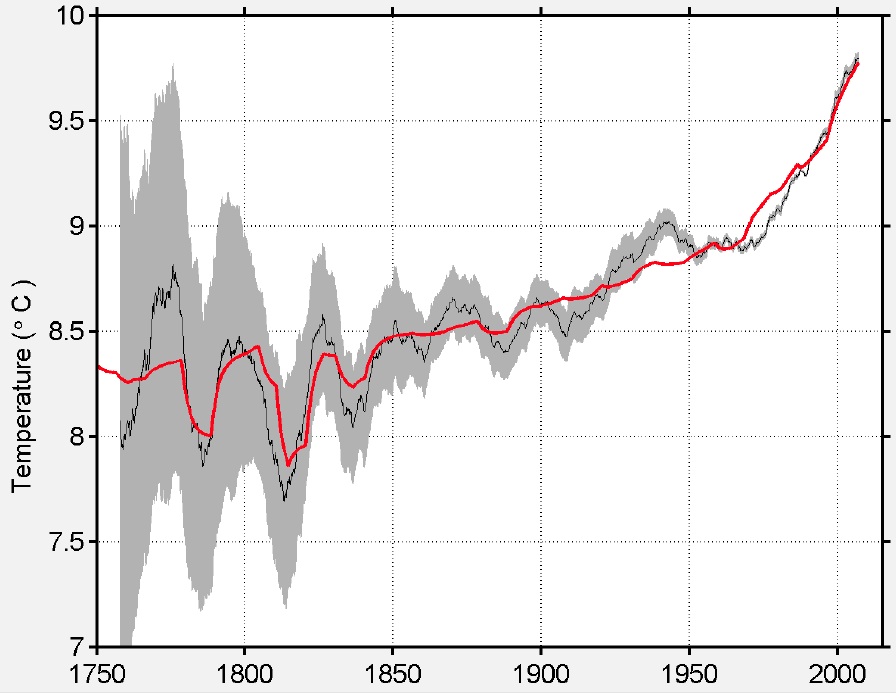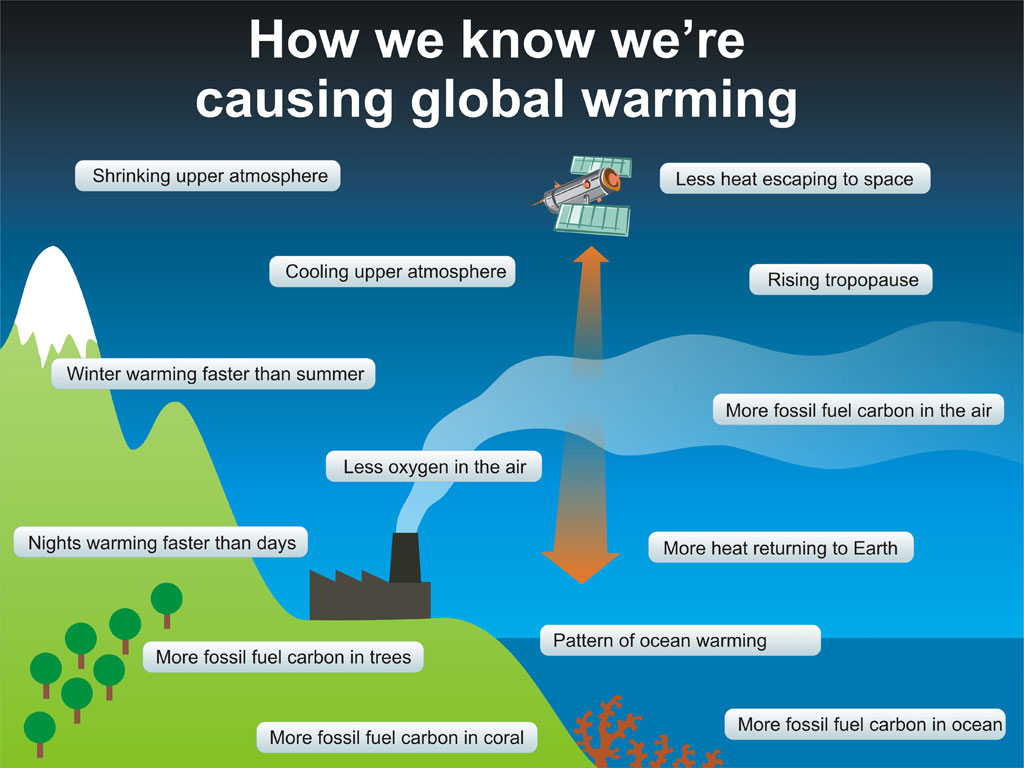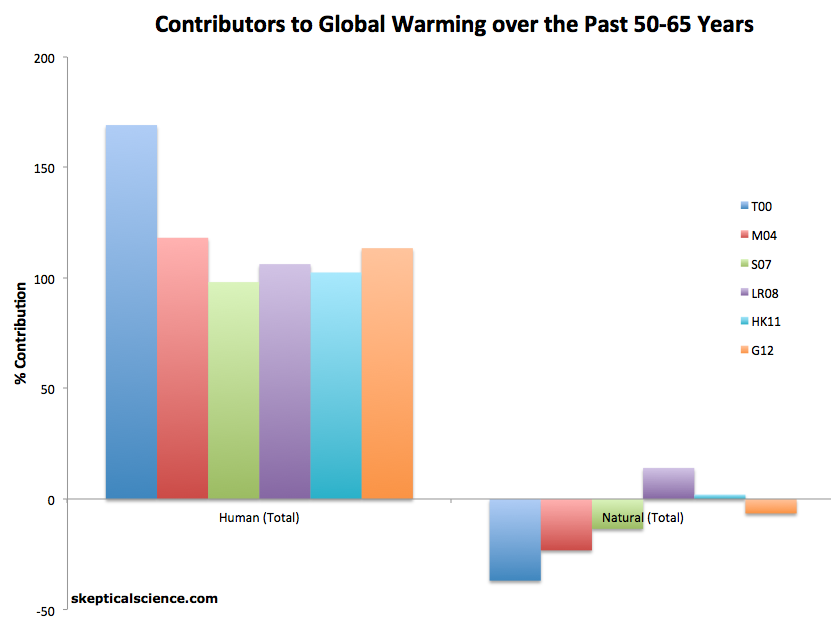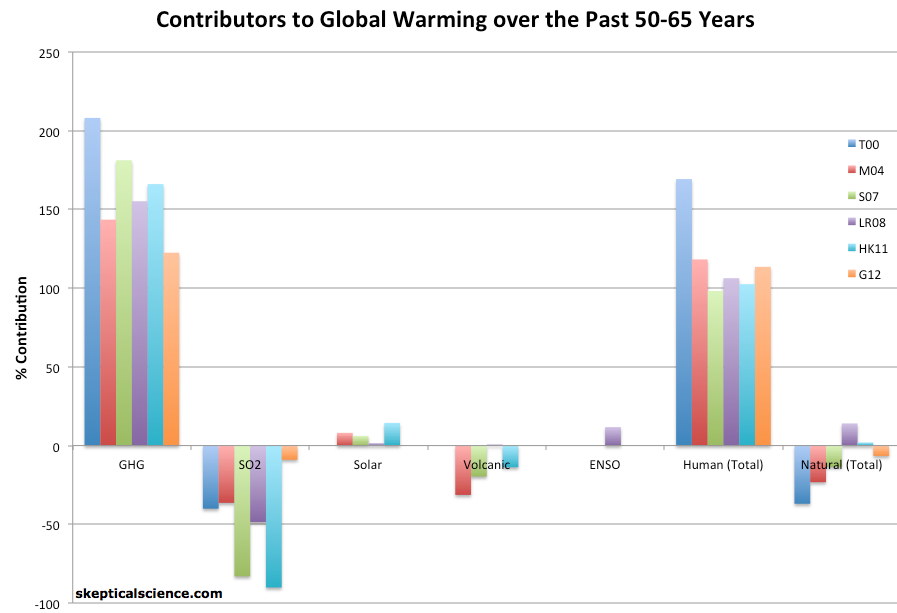BEST Results Consistent with Human-Caused Global Warming
Posted on 3 August 2012 by dana1981
Richard Muller is the head of the Berkeley Earth Surface Temperature (BEST) project, which has just made available a preliminary paper (not yet having passed the peer-review process) regarding the causes of the recent global warming.
Muller started out very skeptical about the accuracy of the surface temperature record and the causes of global warming. For example, see these collections of his skeptical quotes and articles. Muller formed the BEST team to investigate his climate-related skepticism independently, even obtaining funding from the Koch Foundation, whose wealth is primarily derived from fossil fuel interests.
Now despite his prior criticisms of the climate science community (i.e. see our previous Muller posts), Muller and BEST have independently confirmed the accuracy of some of the main components of the body of climate science research. As Muller wrote in an editorial published in the NY Times,
"Call me a converted skeptic. Three years ago I identified problems in previous climate studies that, in my mind, threw doubt on the very existence of global warming. Last year, following an intensive research effort involving a dozen scientists, I concluded that global warming was real and that the prior estimates of the rate of warming were correct. I’m now going a step further: Humans are almost entirely the cause."
As Muller notes, the original BEST results confirmed the accuracy of the surface temperture record, finding 0.87°C global surface warming over land during the past 50 years (Figure 1). The BEST team data and methodology have also been made available to the public for maximum transparency so that anyone can check and attempt to replicate or find flaws therein.
Figure 1: The BEST decadal land-surface average temperature using a 10-year moving average of surface temperatures over land. Anomalies are relative to the Jan 1950 - December 1979 mean. The grey band indicates 95% statistical and spatial uncertainty interval. Click on the graph to also see the 12-month moving average.
Now as Muller notes, the BEST team has weighed in on the causes of that global warming, finding that as the rest of the climate science community had already demonstrated, it is almost entirely due to humans. In response to the BEST announcement, Michael Mann noted:
""
Ken Caldeira told Climate Progress:
"The basic scientific results have been established for a long time now, so I do not see the results of Muller et al as being scientifically important. However, their result may be politically important. It shows that even people who suspect climate scientists of being charlatans, when they take a hard look at the data, see that the climate scientists have been right all along."
The BEST approach in determining the attribution of the observed warming was a simple one, examining the correlations between the various radiative forcings and the temperature data. The BEST team found that greenhouse gases and volcanic eruptions could account for most of the observed temperature change, and suggest that the remainder of the variability is fairly consistent with the Atlantic Multidecadal Oscillation (AMO), an ocean cycle, and very little contribution from changes in solar activity (Figure 2). Note that while the BEST approach is based on correlations, they are correlations of variables with known causal relationships (i.e. an increased greenhouse effect is known to cause global warming), although they do not appear to have considered some important influences like human aerosol emissions or the El Niño Southern Oscillation. Tamino also provides a good critique of the BEST approach.
Figure 2: The decadal land surface temperature from the BEST average (black), compared to a linear combination of volcanic sulfate emissions and the natural logarithm of CO2 (red). Inclusion of a proxy for solar activity did not significantly improve the fit. The grey area is the 95% confidence interval.
However, there is a great deal more evidence for human-caused global warming, using much more robust methodologies than in the new BEST paper. This post, in the Skeptical Science tradition, will look at the full body of scientific evidence regarding the attribution of global warming discussed by Mann and Calderia - how we know humans are the cause:
1) Basic physics - human fossil fuel combustion has increased the greenhouse effect, causing a global energy imbalance, which the planet responds to by warming. Over the past several centuries, human greenhouse gas emissions have caused by far the largest radiative forcing (energy imbalance), and thus must be the driver of any observed long-term global warming.
2) Human fingerprints - there are a number of climate changes we expect to see in response to an increased greenhouse effect. We have indeed observed these changes, which are 'fingerprints' of human-caused global warming.
3) Attribution studies - many studies have been performed to try and determine the causes of the observed global warming, and every such study has been consistent in concluding that humans are the driving force.
1) Basic Physics
For starters, a long-term increase in the average global temperature must be caused by a global energy imbalance - an external radiative forcing. We have observed an increased greenhouse effect with more radiation reaching the surface and less leaving the atmosphere. Scientists have quantified the energy imbalance caused by this increased greenhouse effect, and the radiative forcings associated with various other effects like increasing solar radiation. Overall, they find that by far the largest radiative forcing over the past 250 years comes from the increased greenhouse effect, which we also know is due to human fossil fuel combustion (Figure 3).
Figure 3: Global average radiative forcing in 2005 (best estimates and 5 to 95% uncertainty ranges) with respect to 1750 (IPCC AR4).
It's just fundamental physics that this large radiative forcing must result in global warming until the Earth reaches a new energy equilibrium at a higher temperature. For 'skeptics' to make a convincing argument that humans are not causing global warming, they must both explain where this large greenhouse gas radiative forcing has gone, and find an even larger 'natural' radiative forcing which nobody has yet identified. Until the 'skeptics' can explain this, the evidence clearly indicates that humans are driving global warming.
2) Human Fingerprints
There are also a number of 'fingerprints' which are either indicative of or consistent with what we expect from global warming caused by an increased greenhouse effect. For example, we expect to see the lower atmosphere warm and the upper atmosphere cool, because greenhouse gases are primarily located in the lower atmosphere, and effectively trap heat there. More radiation is directed back towards the surface, less makes it up into the upper atmosphere. There are many other examples of human global warming 'fingerprints' (Figure 4).
Figure 4: Fingerprints of human-caused global warming.
3) Attribution Studies
As we have previously discussed, there have been a great many studies using various different approaches to determine the causes of the observed global warming. Every such attribution study has been consistent in concluding that humans are driving global warming (Figure 5), with greenhouse gases causing more than 100% of the observed warming because much of that is offset by the cooling effects of human aerosol emissions, which block sunlight (Figure 6).
Figure 5: Net human and natural percent contributions to the observed global surface warming over the past 50-65 years according to Tett et al. 2000 (T00, dark blue), Meehl et al. 2004 (M04, red), Stone et al. 2007 (S07, green), Lean and Rind 2008 (LR08, purple), Huber and Knutti 2011 (HK11, light blue), and Gillett et al. 2012 (G12, orange).
Figure 6: Percent contributions of various effects to the observed global surface warming over the past 50-65 years according to Tett et al. 2000 (T00, dark blue), Meehl et al. 2004 (M04, red), Stone et al. 2007 (S07, green), Lean and Rind 2008 (LR08, purple), Huber and Knutti 2011 (HK11, light blue), and Gillett et al. 2012 (G12, orange).
All of these studies find that humans are responsible for close to 100% of the observed global warming over the past 50 years, and human greenhouse gas emissions are responsible for close to 150% of the observed warming, with human aerosol (sulfur dioxide - SO2) emissions offsetting approximately one-third to one-half of that greenhouse warming.
As Michael Mann noted, this is not a new conclusion. In fact, climate scientists first reached a consensus that the human influence on climate change was observable way back in 1995 in the IPCC Second Assessment Report, which concluded:
"The balance of evidence suggests a discernible human influence on global climate"
This conclusion became stronger in the 2001 IPCC Third Assessment Report, which concluded:
"most of the observed warming over the last 50 years is likely to have been due to the increase in greenhouse gas concentrations"
"Likely" corresponds to greater than 66% probability. In the 2007 IPCC Fourth Assessment Report, confidence in this statement grew even stronger to "very likely", which corresponds to greater than 90% probability.
Long Story Short, We're Causing Global Warming
On top of these many lines of evidence which mostly focused on global warming at the surface, Gleckler et al. (2012) also confirmed that the warming of the oceans has been caused by humans. While it's nice that Muller and the BEST team have confirmed human-caused global warming to their own satisfaction, it is not a new result by any stretch of the imagination, and there have been a number of studies with far more robust methodology arriving at the same conclusion.
The BEST team also found that the observed warming is consistent with an equilibrium climate sensitivity of 3.1 ± 0.3°C for CO2 doubling, in line with the IPCC climate sensitivity range, and demonstrates once again that contrary to the persistent claims of Richard Lindzen, the Earth has warmed as much as we expect given a relatively high climate sensitivity.
The bottom line is that humans are the driving force behind the current global warming. Muller and the BEST team are good scientists, so it was inevitable that they would eventually agree with the body of scientific literature on this issue.































 Arguments
Arguments




































What am I to make about this guy Muller? To me he seems really inconsistent. Unless you take into account that he is often promoting natural gas and fracking. (before and after his 'conversion')
He still uses his 'old ways' sometimes to diminish AGW, even after claiming that he is certain AGW is real. Why then is he still advocating the use of a fossil fuel? Even a method shown to be really devastating to earth's climate.
One of the things that got me convinced that he is shady is his claim that 'hide the decline' is a reference to temperatures. This was a while after when the investigation of the scientists took place. It seems to me that he might be a covert shill for natural gas. The 'conversion' study was sponsored by Koch. He seems to be balancing on a tightrope.
The study accomplished two things:
1. Good for 'skeptical' public: there is a new independent study acknowledging antropogenic global warming. Deniers will have a hard time denying this. True skeptics in the general public will be more inclined to taking AGW serious.
2. Good for Koch: there is a new 'trustworthy' scientist risen, who in order to curb global warming, is advocating the burning of Natural Gas and the 'clean' technique of fracking. Natural gas containing 80% methane. Methane: stays not as long in the atmosphere as CO2, but does have a greater greenhouse effect.
What am I to make of this? Can someone explain why natural gas is a better solution than renewables. Muller seems to think it is the only real affordable option we have. Renewables are as of now too expensive. (what about nuclear energy?)
qinqo, my take on Muller is that he bought in to the whole 'climate change is a hoax' mythology hook line and sinker, but had enough integrity to acknowledge when his own research disproved (again, past research had done so before he ever started) one of those lies. Unfortunately, the same failures of logic and character which led him to buy into complete nonsense in the first place have also prevented him from thinking, 'Gee, I just made a fool of myself... maybe I should re-evaluate some of this stuff'... and thus he continues to make completely ridiculous claims on other aspects of the global warming 'debate'.
Basically, if he has done research he'll go with what his data shows, but if he hasn't done the research he'll go with the 'skeptic' misinformation. It seems like he may think he is the only competent scientist on the planet... because he places the blog rantings of 'skeptics' above peer-reviewed research from the scientific community.